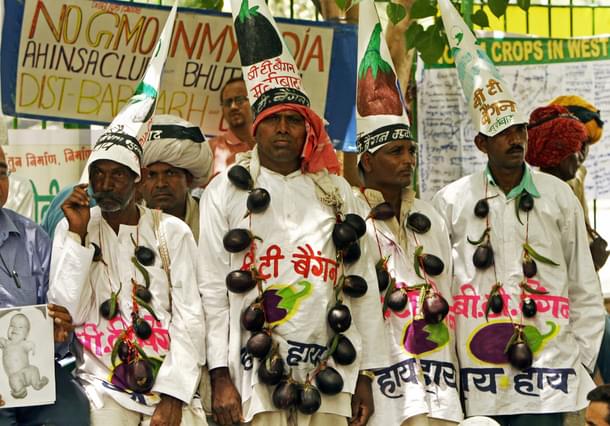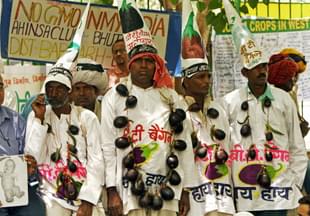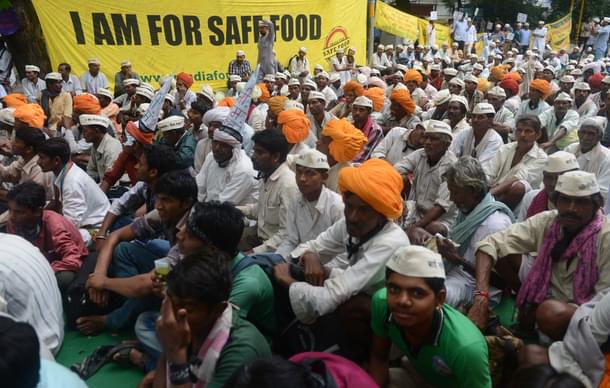Politics
Anti-GMO Lobby Has No Scientific Rationale To Stand On. It's Time We Listened To Our Scientists
Surajit Dasgupta
Feb 16, 2016, 08:43 PM | Updated 03:13 PM IST
Save & read from anywhere!
Bookmark stories for easy access on any device or the Swarajya app.


After treating them with contempt for years together for being anti-science people, I felt like appreciating them for the first time last week when reports saying that the anti-GMO brigade has demanded release of scientific data pertaining to a genetically modified mustard variety emerged.
If the activists’ concerns are the following, they would be valid:
- Regulators in this country must examine the genetic modification, its protein products, and any intended changes that those proteins make to the food.
- They must also check whether the food derived from a GMO is substantially equivalent to its non-GM-derived counterpart, which provides a way to detect any negative non-intended consequences of the genetic engineering.
- If the newly incorporated protein is not similar to that of other proteins found in food or if anomalies arise in the substantial equivalence comparison, further toxicological testing must be ordered by the state.
– Quoted from a policy paper authored by this columnist.
Report after report will tell you that the concerns above are but an activist’s red herring. They wouldn’t allow even a meeting between the scientists [Centre for Genetic Manipulation of Crop Plants (CGMCP)] and the Indian regulator [Genetic Engineering Appraisal Committee (GEAC)] to take place. They don’t wait to block GM crops’ commercial use, which is the last stage in the production-to-sale chain; they wouldn’t even allow field trials! Without consultation and experimentation, how would they know which hybrid would be toxic by what degree or be absolutely harmless?
The appreciation for the activists was unsurprisingly short-lived. The very next day we came to know of a rather valid reason for keeping the data confidential.
The developer of the variety was waiting for the approval of DMH11 (Dhara Mustard Hybrid 11) by the government. With the issue of intellectual property rights involved, the group of geneticists who developed the breed would obviously not divulge the details out of the apprehension of losing the patent to formula thieves. “(Deepak) Pental said he would provide all the new clarifications that have been sought from him. He said he was also willing to put all the biosafety data in the public domain once the GEAC gives the final approval,” read the follow-up report.
Before half-baked intellectuals of the Internet variety, equipped with misleading information fed by sundry dot org websites run by interest groups in the US — where these activists’ ringmasters are curiously inactive — pounce on the opportunity to scream M-O-N-S-A-N-T-O, they must be shut up with the fact that DMH11 is a fully homegrown genetically engineered crop. Pental (mentioned above) is the former vice-chancellor of the University of Delhi who heads the wholly indigenous CGMCP that developed the crop. The breed passed the Biosafety Research Level-1 (BRL-1) tests in Rajasthan in 2011-12 and 2012-13. The National Research Centre for Rapeseed-Mustard at Bharatpur coordinated the process involving the producers and the examiners. The Indian Agriculture Research Institute of Delhi and the Punjab Agricultural University cleared the breed in the BRL-2 tests in 2014-15.
Luddite activists are utterly discomfited when they cannot trace a Wal-Mart in a debate on retail and Monsanto in a debate on genetically modified organisms (GMOs). Then they resort to slander. One wishes a scientist dragged them to the court on a charge of libel. They would say geneticists across the world who have ever spoken in favour of any GM crop are on the payrolls of Monsanto. No proof required! Ask them to name a particular scientist whose professional integrity can be questioned, and they can’t.
- As the editor of CII’s Pharma Communiqué in 2009, I had interviewed Dr Swapan Kumar Datta, then deputy director general (crop sciences) of the Indian Council of Agricultural Research (ICAR), who slammed the activists for damning genetics as a whole instead of pinpointing specific breeds. Is he on Monsanto’s payroll?
- Are the Ministry of Agriculture & Farmers’ Welfare, ICAR, Indian Agricultural Research Institute, Department of Agricultural Research and Education, Department of Agriculture, Cooperation and Farmers’ Welfare, Department of Animal Husbandry, Dairying and Fisheries and an assortment of agricultural universities in this country wings of Monsanto?
- One finds the exposition, “Plant Genetics, Sustainable Agriculture and Global Food Security,” by Pamela Ronald of the Department of Plant Pathology, University of California, credible. Is Ronald a Monsanto beneficiary?
- The article, “Legally mandating GM food labels could mislead and falsely alarm consumers,” by the Board of Directors of the American Association for the Advancement of Science, dated 25 October 2012, is trustworthy. Is this entire board bought up by Monsanto?
- S Key, JK Ma and PM Drake’s 2008 dissertation, “Genetically modified plants and human health” is a veritable work on both advantages and challenges in GM crops. Are Key, Ma and Drake bidding for Monsanto?
- The American Medical Association’s 2012 paper, “Report 2 of the Council on Science and Public Health: Labelling of Bioengineered Foods,” explains what no science-illiterate activist can. Is the association a front of Monsanto?
- Has Monsanto paid for the United States Institute of Medicine and National Research Council’s 2004 paper: “Safety of Genetically Engineered Foods: Approaches to Assessing Unintended Health Effects”?
- Erudite columnist Anand Ranganathan put all speculative allegations regarding GM crops to rest in his three-part series: “Exploring GM foods” Part I, Part II and Part III. Is Ranganathan a Monsanto lobbyist?
The answer to all the eight questions above is “no”. The rabble rousers better not question the honesty of these scientists and science writers, lest they should be pulled up for defamation. Wild charges levelled on the whole group with no mention of specifics, unfortunately, cannot be stopped.

Ironically, on the other hand, the ‘scientists’ the activists champion can be proved either to be peddling half-truths or to be furthering the interest of one of the numerous lobbies in the First World whose prime agenda is to scare the emerging economies of perceived side effects of technology that catapulted their own countries to the top, post-Industrial Revolution. The idea behind this scare-mongering is to halt the progress in developing countries so that they cannot pose a threat to American and European goods in the international market in future.
Half truths
This is a standard weapon in the hands of all private websites promoting cults: be it a Christian website damning homosexuality, a Muslim website condemning pork, a Hindu website slamming beef, a maker of tinned vegan dishes cursing non-vegetarian food, a trader’s cartel spreading paranoia about FDI in retail or an indirect player in agriculture forbidding genetic modification of crops.
Sample this. Vegetarians often further the name of T Colin Campbell to legitimise their campaign. Google search the name of this biochemist and nutritional propagandist — one of the two authors of The China Study, the other being his son Thomas M Campbell — and you get sites such as this one or this, which show that Campbell’s hypothesis is not endorsed by his peers.
Ditto in the GMO debate! There is this dubious character called Dr Joseph Mercola who sells conspiracy theories like this one. There is a self-styled “Institute of Science in Society”; a name of the type would naturally evoke enough respect for a reader to buy its theories credulously. But if Google is your ‘university’, you better check out their credentials using the search engine.
This is what one gets to know about Mercola:
The information he’s putting out to the public is extremely misleading and potentially very dangerous,” opines Dr. Stephen Barrett, who runs the medical watchdog site Quackwatch.org. “He exaggerates the risks and potential dangers of legitimate science-based medical care, and he promotes a lot of unsubstantiated ideas and sells [certain] products with claims that are misleading.
For technical perfectionists, Google Scholar — rather than ordinary Google — is recommended.
A classic case of Internet activism is that of an article like “Harmful effects of the agent.” It is an essay that is not authoritative. It does not name the author or his/her team. It looks like a high school level essay that ends in seven paragraphs, with no citation against any claim except one of Bernstein and another of Bakshi dated 2003. If a reader studies the whole of Jonathan A Bernstein and Anita Bakshi’s theses, s/he can note that this anonymous author cherry-picked statements from their works as per his/her convenience. At best, a section of the population has been found allergic to some GMO varieties. But then, no GMO advocate ever asked for acceptance of all GM products. Accept what is proven harmless; discard what is not!
Interest groups aka lobbies
The ISIS above is not the terrorist organisation Daesh; it’s a demagogue. It turns out to be an interest group (euphemism for a lobby) whose falsehoods have long been exposed.
But do we have these Campbells and Mercolas in our midst, too? Mercifully, Indian activists have not claimed to hold degrees in biological sciences yet, but there is enough content to expose their politics. Take Vandana Shiva, for instance. Being a physicist, she has a legitimate claim to being a scientist, no doubt. But what makes her hypothesise on botany? One may go through the names of her associates in the website of Organic Consumers Association: Rosana Álvarez, Mary Anselment, Alexis Baden-Mayer… Robin Seydel, John Stauber. Not one of them an Indian except her! Why don’t these Americans and Europeans hold the cities of the United States to ransom for approving all kinds of GM crops?
One may similarly question the International Forum on Globalization of which Shiva is a part. All but three on its board are from countries where GM crops are very much approved for mass use: Debbie Barker, Bing Gong, John Cavanagh and Jerry Mander (American), Jack Santa-Barbara (American-turned-New Zealander), Anuradha Mittal (American of Indian origin), Maude Barlow and Tony Clarke (Canadian), Walden Bello and Victoria Tauli-Corpuz (Filipino), late Edward Goldsmith, Martin Khor (Malaysian), Sara Larraín (Chilean), Meenakshi Raman and Vandana Shiva. Shouldn’t Mittal, Raman and Shiva be expected to tell their colleagues to howl and protest in their own countries first? She has also been described as a “proud self-declared Luddite”. Citing instances of biotechnology in routine grains that lay consumers believe have been grown traditionally, Michael Specter says, “… statistics have not deterred Shiva.”
The other ubiquitous agitator is a certain Devinder Sharma based in Punjab’s Mohali — often invited to television studios to heckle panellists with a deeper knowledge of plant genetics. He was a regular on television in 2011-12, promoting both India against Corruption and Bharat Swabhiman. He was a favourite of the champion conspiracy theorist, Rajiv Dixit when the latter was alive. A big hit with buyers of wild accusations on Facebook and Twitter, Sharma is no agriculture scientist. I challenged him to debate every point on the subject. Finally, one day he said I could debate with his assistants. Seems he is a ‘scientist’ with an air of a VIP. Anyway, his deputies didn’t turn up for a debate either.
The likes of Shiva pain us more. She may not be a botanist or geneticist, but physics should have injected into her adequate doses of scientific temper. We, unfortunately, do not see this discernment in IIT-Kharagpur alumnus and Delhi Chief Minister Arvind Kejriwal and mathematics postgraduate and former RSS pracharak KN Govindacharya either. They are not even concerned about brand differentiation in politics when they make common cause with economist and CPI(M) general secretary Sitaram Yechury in condemning the science of genetics. And now a semi-educated Manish Sisodia is batting for his boss!
Paradoxically, this lot cries foul over low farmer income, farmer suicides, occasional drop in agricultural production and food price inflation! How do you increase a farmer’s income and lessen our expenses if you keep big retailers out, who could reduce the production-consumption chain drastically and offer both the producer and the consumer better prices? How do you increase agricultural production when you are pathologically averse to high-yield, disease-resistant crops? Even an otherwise GM-sceptic Scientific American (Nature) finds no merit in the allegation that transgenic crops have led to farmer suicides.

“Organic farming,” pat comes the reply from these activists! This reminds one of a pre-Budget seminar in 2015 addressed by former finance minister Yashwant Sinha. Taking a dig at Swadeshi Jagaran Manch’s Ashwani Mahajan sharing the dais with him, he said, “We have tried everything that you activists want us to do. It doesn’t work.” Indeed, whether you rotate crops, leave some farm produce to rot naturally to get green manure, make the livestock defecate for compost or kill pests using other living organisms — your yield or income will never be as high as what the GM counterpart can give you.
For high income, farmers would need a price premium. A comprehensive study, “Organic and Conventional Production Systems in the Wisconsin Integrated Cropping Systems Trial: II. Economic and Risk Analysis 1993–2006” by Jean-Paul Chavas, Joshua L Posner and Janet L Hedtcke in the Agronomy Journal101 (2), says, “When government programs and organic price premiums are included, returns increased by 85 to 110 per cent for the organic grain system… and 35 to 40 per cent for the organic forage system…” [p 288]. That is, without government support (your and my money) — instances of which in India are aplenty — organic farming does not lead to substantially increased income for the farmers. Whereas, sowing GM varieties of seeds would themselves lead to rich harvests. “The lower GM crop prices mean improved international competitiveness for exporters of these crops,” reads an article by Chantal Pohl Nielsen (Danish Institute of Agricultural and Fisheries Economics), Karen Thierfelder (US Naval Academy) and Sherman Robinson (International Food Policy Research Institute) in the book Consumer Acceptance of Genetically Modified Foods that deals with the economics of GM foods exhaustively [page 221].
To make organic farming profitable, our farmers also need farmers’ markets, whereas the naysayers of the left and right alike are averse to removing middlemen from the retail chain, too!
Finally, whose interest is this “swadeshi” lobby furthering? It’s of any entity except India. By blocking genetically modified mustard developed indigenously — with no trace of Monsanto’s ghost — they will only help foreigners sell their edible oils to us beyond the present level of 70 per cent of our needs.
Also, blame Minister for Environment and Forests Prakash Javadekar. One wonders why the GEAC should invite members of the Coalition for GM-Free India for consultation. When your name contains the term “GM-Free”, will you accept anything GM — whether the breed is indigenous or foreign? The minister says he wants to consult “the people” before giving a green signal to DMH11. Given the highly technical nature of the subject, the statement is analogous to holding a referendum on possible treatments of a complicated disease instead of consulting medical experts! Since when has Javadekar been infected by the Kejriwal disease?





